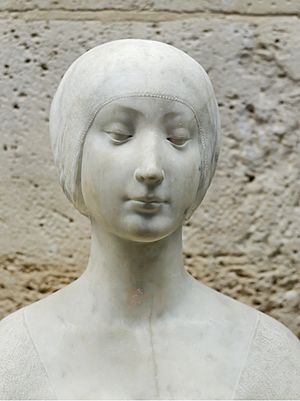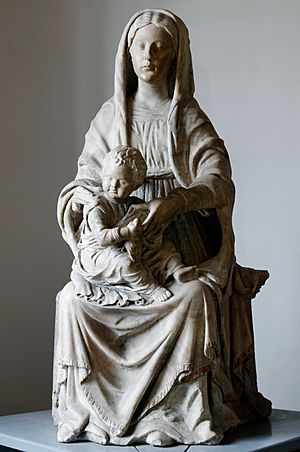Francesco Laurana facts for kids

Francesco Laurana (born around 1430 – died before March 12, 1502) was a famous sculptor and medallist. He was from Dalmatia, a region that is now part of Croatia. People consider him both a Croatian and an Italian artist.
Laurana was born in an area controlled by the Republic of Venice. However, he spent most of his career working in different parts of Italy, like Naples, Sicily, and Urbino. Later, he moved to southern France, where he passed away. He was one of the most important sculptors of the 15th century. His portrait busts are especially well-known for their unique style.
Contents
Life and Artworks
Francesco Laurana was born in a town called Vrana, near Zadar. This area is in Dalmatia. When Vrana was under Venetian rule, it was called La Vrana. This is where Francesco got his surname, Laurana.
After learning from another sculptor, Laurana started his own career in Naples. There, he joined a team of sculptors. They were working on a grand arch for the Castel Nuovo, a large castle. This project was for King Alfonso V of Aragon.
Working for King René
After King Alfonso died in 1458, Laurana moved to Aix-en-Provence in France. He went to work for René d'Anjou. King René was a former king of Naples. He asked Laurana to create a series of bronze portrait medals. These medals showed important people from his royal court.
Time in Sicily
From 1466 to 1471, Laurana worked in Sicily. During this time, he created several important pieces. These include the Mastrantonio Chapel and the tomb of Pietro Speciale. Both are in the church of S. Francesco in Palermo.
He also made the side door of the church of St. Marguerite in Sciacca. Laurana sculpted Madonna and Child statues for cathedrals. You can find these in the cathedrals of Palermo (made in 1471) and Noto. He also made a famous bust. Many believe it shows Eleanor of Aragon. This bust is now in the Palazzo Abatellis in Palermo.
Return to Naples and Urbino
In 1471, Laurana returned to Naples. There, he created a sculpture of the Virgin for the Sta. Barbara Chapel. From 1474 to 1477, Laurana spent three years in Urbino. His relative, Luciano Laurana, who was also an architect, worked there.
Later Works in France
After Urbino, Laurana moved to Marseille, France. He built a small chapel inside the Cathedral of S. Marie Majeure. This chapel (built between 1475 and 1481) was very special. It was the first building in France designed completely in the Renaissance style.
His workshop in Marseille created other artworks. These include the St. Lazarus marble altar. They also made the retable of the Calvary in St. Didier d'Avignon. Laurana also sculpted tombs for important people. These include Giovanni Cossa at Sainte-Marthe de Tarascon. He also made the tomb for Charles, comte du Maine, in Le Mans.
Francesco Laurana died in 1502. He passed away either in Marseille or Avignon, France.
 In Spanish: Francesco Laurana para niños
In Spanish: Francesco Laurana para niños


